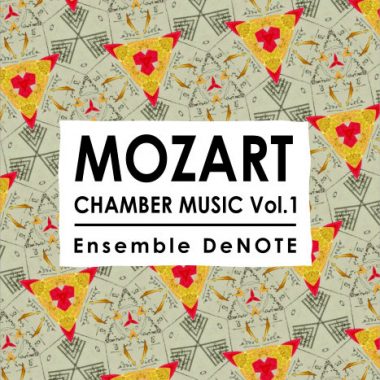Mozart Chamber Music Vol. 1
Ensemble DeNOTE
Devine Music DMCD007. 70’43

Sonata for Piano and Violin in B flat, K.454
‘Kegelstatt’ Trio for Clarinet, Viola and Piano in E flat, K.498
Piano Quartet in G minor, K.478
There is more to this recording than meets the eye – or, indeed, the ear. At one level it is an excellent recording of some, perhaps lesser-known, music by Mozart, played on period instruments with considerable (and appropriate) style by Ensemble DeNOTE. On that basis alone, it is well worth getting hold of. But what marks this out as being very different from a normal run-of-the-mill Mozart CD is its background. It grew out of 2016 staged performances of Mozart given by DeNOTE as part of their (Arts Council funded) Mozart Project Live!, itself an extension of the earlier Mozart Project, an award-winning interactive digital book with contributions from DeNOTE’s director, fortepianist, John Irving. For their Mozart Project Live! they performed extracts from the three pieces on this recording, along with spoken and acted introductions from two actors, in period dress but clutching 21st-century tablets, and audio and video material from the digital book. But there was not enough time for complete performances of the three pieces demonstrated, hence this recording. It contrasts three works from the 1780s for two, three and four instruments, all including the fortepiano.
The opening K.454 Sonata for Piano and Violin was written in 1784 for the Viennese debut of the Mantuan violinist Regina Strinasacchi (a former student of the Ospedale della Pietà in Venice), then in her early 20s. It was written in some haste, to the extent that Mozart had no time to write out his piano part. For the public performance, apparently in the company of the Emperor Joseph II, he put a blank sheet of paper on the music desk, but played from memory and, presumably, a great deal of improvisation. It is a piece full of contrast, unusually starting with an expansive Largo before bursting into a lively Allegretto. The compositional blend between the two instruments is notable, each sharing the limelight alongside lengthy passages where the two combine in close consort. The players’ subtle additions to the text are entirely appropriate.
The incorrectly named Kegelstatt Trio (for Clarinet, Viola and Piano) (the name was intended for another piece, not this one) breaks the conventional rules of composition, the three movements (Andante, Menuetto, Rondeaux: Allegretto) bearing little relation to the expected three-movement sequence. Although the instruments (unique at the time) in the final movement, the fortepiano takes centre stage for a while, before the other two instruments have their moments in the foreground. Incidentally, Mozart is said to have played the viola for this, not the piano.
The concluding Piano Quartet in G minor (K.478) also has a back story – or might have. Although commissioned (as a set of three) for Vienna’s amateur performers, the piano part turned out to be far too difficult for them to play. Along with that, the thought of four amateur musicians attempting to play this complex work was deemed, at best, undesirable. Refusing to write something easier, the commission was cancelled, leaving this one Quartet, one of the first of its kind in musical history. That is the story, but recent scholarship, outlined in the CDs liner notes, casts doubt on this story. In the dark key of G minor, it is certainly of an emotional depth and intensity that requires musical and expressive experience possibly beyond many amateurs. Only in the final movement does any semblance of domestic music-making begin to appear. As with the other pieces on this recording, the four instruments are treated as equals and, as with the other pieces, the recording balance is well judged between them, the fortepiano (a copy of a c1795 Walter) being at just the right volume to blend without dominating.
The individual performances, from Marcus Barcham-Stevens, violin, Oliver Wilson, viola, Ruth Alford, cello, Jane Booth, clarinet, and John Irving, fortepiano, are excellent. But, more importantly, the overall result greatly exceeds the sum of the individual parts – as it always should in consort playing.

2 thoughts on “Mozart Chamber Music: Vol. 1”